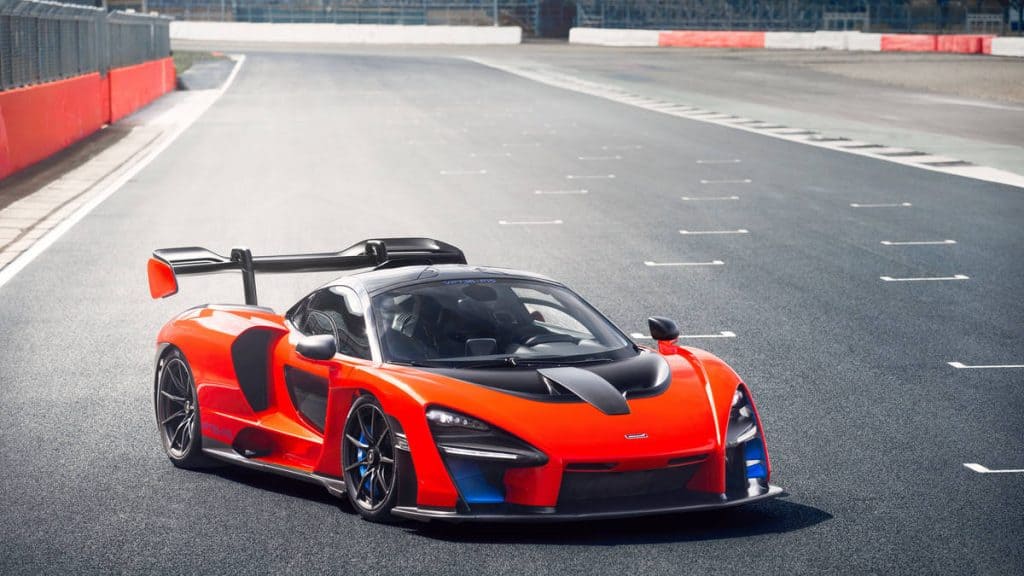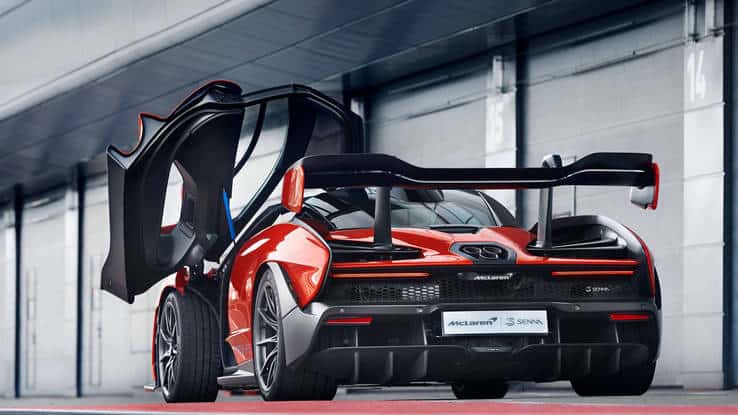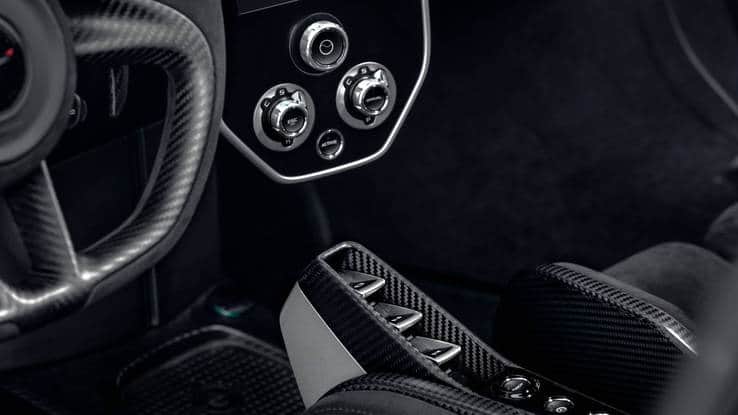I’ve been a fan of McLaren from way back when Ayrton Senna seemed to be invincible in Formula 1. And I was as devastated when his life came to an end at the San Merino Grand Prix in 1994 when leading the race for Williams. I’ve slowly collected some minor pieces of Senna memorabilia over the years but how I’d like to add the McLaren Senna to my collection.

No chance of that, but the 500 people who have pre-ordered the 500 examples must be pretty chuffed. McLaren driver may get one as his year end bonus?
There are some lucky so and so’s around the world who get a chance to test drive supercars and hypercars and for those who drove the Senna recently, I say thanks for the reports. No jealousy, no anger just a sit back and take it all in. Here’s the story on the McLaren Senna from Ben Barry of Autoweek with pictures from the online magazine acknowledged
“McLaren’s new road-legal track toy is at its most dramatic when it’s doing the impossible with poise”
MAY 1, 2018
When McLaren bills its latest model “the ultimate road-legal track car,” our expectations are already pummeling the rev limiter. When they name it after a Formula 1 triple world champion deified for his car control and racing instinct, well, the pistons are practically bursting through the block.
Today, we’re at Silverstone to drive the McLaren Senna to figure out if this $958,966 track toy can live up to those heady expectations and justify the price.
Your heart rate spikes just reading the specs: 789 hp, 590 lb-ft, 1,764 pounds of downforce at 155 mph and a lightest dry weight of 2,641 pounds. Flatten the accelerator from rest and you hit 60 mph in 2.7 seconds, 124 mph in 6.8, blow through the quarter-mile in 9.9 and reach 186 mph in 17.5. Seriously.
The Senna does share basic hardware with the almost four-times cheaper 720S — including its carbon-fiber MonoCell III passenger cell, 4.0-liter V8 twin-turbo engine and dual-clutch gearbox — but all are upgraded.
We are not driving the production car. This is a verification prototype, the final sign-off before 500 production cars roll down the McLaren Technology Centre line. But vehicle line director Andy Palmer says it is “fully representative in terms of chassis and powertrain.”
Unfortunately, it’s also fully representative in terms of design — parked in the Silverstone pits, the Senna looks more like a full-size Lego replica of a McLaren than a real one. The front overhang is in a different time zone than the front axle, boxy side air intakes jar against the teardrop glasshouse and the rear wing would risk ridicule at SEMA. McLaren calls it “brutal,” the logical output of punching “form follows function” into its supercomputer and seeing what happens.
Somehow it looks less awkward in the carbon flesh than it does in photos, but the P1 hypercar channels its brutal functionality in a much more stirring way. Behind the wheel, though, who cares, right?

The execution
The Senna’s dihedral door floats open — the carbon structure weighs just 21.8 pounds — and takes a chunk of the roof in the process, so it’s easy to climb over the carbon sill and into the cockpit wearing a helmet. The carbon-fiber seat is canted back like a race car and weighs just 7.4 pounds, taking the P, N and D controls for the transmission with it as it slides back and forth. The seat is snugly comfortable and the driving position is excellent. There’s an airiness and comfort to this cabin that calms your nerves, though it’d be a lie to say I’m not apprehensive.
We’re in race mode, so the Senna’s dropped 1.2 inches front and 0.9 inch rear on its hydraulically interconnected suspension, contributing 50 percent more downforce and introducing the suck of ground-effect aero. We won’t sample the other modes until the production-car launch at Estoril.
Racer Euan Hankey is the passenger. Cold tires — go easy at first, he cautions as we ease from the pits without a race car’s vibrations. At 7/10ths, the Senna is docile and unintimidating. You notice there’s extra mechanical energy tingling through the car’s seat than in a 720S thanks to solid engine mounts — and more raw noise, too: The roof snorkel, titanium exhaust and the stripped cabin all contribute.
You also notice the steering’s perfect precision. It’s light and fast enough to make those early interactions feel effortless and put you firmly in control, but weighty enough to provide meat to work against and render your subtlest inputs in minute detail. Accelerate and the throttle fizzes with energy and response. Somehow this engine seems less boosty than other McLarens, all of which use different twists on the same V8 theme. It’s more progressive in its delivery, perhaps because it’s propelling less mass.
The dual-clutch gearbox’s shifts lack the mechanical ferocity you might expect of a machine so ruthlessly focused, but in race, they’re calibrated for maximum speed, so the ratios blur by in one seamless stream; in track, a cylinder-cut function promises to sacrifice speed for a more emotive punch, like the childish buzz of powersliding applied to gearbox software — slightly perverse, but logical all the same.
If you haven’t already done so, take a minute and really look at the McLaren 720S — in person, if you can find one, but photos will do for now. It’s long, low, wide: everything a supercar …
Tires warmed, it’s time to try harder. There’s a raucous thrash from the twin-turbo V8. The noise, the rush of speed and a very quick glance at revs rising like a helium balloon says I’m near the limiter, but I’m still not tapping the peak 789 hp at 7,250 rpm. Hold out for the blue light at the top of the dash, instructs Hankey. The Senna’s domestic appliance soundtrack disappoints, but the way it continues to gather speed so ferociously with those final few rpms makes accelerating right up to the braking marker seriously intense, like jumping from a train’s path just in time. Things are moving so quickly, you really need the blue light to catch your attention rather than looking for it.
Into the fast right-hander at Abbey, I sense weight shifting forward under the brief braking phase, but there’s surprisingly little pitch as the hydraulically interconnected suspension works its magic. Likewise, there’s some body roll during turn-in, communicating the building lateral loads. It feels natural, progressively managed and sweetly suppressed. If the body feels as tied down as you’d expect of a track toy, the compliance is more surprising — later, when I get greedy with the curb and brace for impact, it softens the blow to almost nothing at all.

The composure gives you huge confidence to brake later and jump straight back on the throttle, whereas a 720S would squirm and slide and demand more corrective actions. But it’s still a mental leap to pin the throttle through the fast left-hander — named Farm — following Abbey, and believe in the downforce. It’s like those team-building exercises where you fall back and trust your colleagues to catch you. In the first laps, I can’t do it. Loosen your arms, says Hankey; let the car flow toward the center of the track. When I eventually disconnect my brain and follow instructions, the sensation of lateral g force rushing to my right like a tidal wave as freefall speed swirls the Senna forward is pretty overwhelming. I can’t help but shout “Woooooow!” into the intercom at Hankey all the way through the turn.
The Senna is equally “woooooow!” through slower corners. Stand hard on the 15-inch (390 mm) — same size all-round, unusually — carbon-ceramic brakes and they stop the Senna faster than a Prost at a Japanese chicane. The pedal bites instantly, there’s meaty pressure to work against, but it’s not dead like some race car pedals; you can modulate and really feel what’s going on. McLaren claims the Senna stops from 124 mph in 328 feet, 52 fewer than the P1 hypercar — entirely believable given the deceleration I’ve just experienced, and all without the ABS’ messy stutter.
More nuanced is how calm the Senna’s body still feels slowing brutally from fifth to second. Again, that’s the front suspension firming up to combat pitch under much heavier braking, but also the active aero bleeding away excess front downforce so the rear doesn’t loosen and squirm around. It must be mind-bendingly difficult to calibrate — all the more impressive it feels so unfiltered and natural.
Aim for the apex and the front Pirelli Trofeo Rs key into the surface with surprisingly little scrub or flex, and their bite, the chassis composure and the low weight helps the Senna flick energetically through the slow left-right direction change at Vale.
Traction, too, is impressive, especially given the aero isn’t doing much at these speeds, though it seems natural to short-shift to keep things tidy. All the while, the stability systems work away subtly in the background. When Hankey finally gets me to go as hard as I can through the fast left-hander at Farm, it logically follows I’m super-late on the brakes for the tight right at Village. I brake heavily through the apex and the Senna oversteers with the clawy grip of a cat dragged from a sofa. I wind on corrective lock and I swear the stability systems do nothing at all. On a steady throttle at high speeds and low, you also feel some safety understeer creep in without intervention when you nudge the limits — the systems are more proactive at quelling wheelspin than yaw.
After a blur of laps, Hankey points at the pits and I try to contextualize what just happened. It’s funny because you’re aware the Senna is almost otherworldly in its competence, but it also feels entirely intuitive in that it’s simply doing your bidding, no matter if you’re making such unreasonable requests. Because of this, I actually find the Senna easier to drive quickly than the 720S we did our familiarization laps in; that car is much more lurid.
You could argue the Senna is less dramatic and involving than a 720S as a result, but I’d argue this is dramatic in a different way: more a race car experience accessible to even modestly talented drivers, and it absolutely still demands commitment to take to its limits.
The takeaway
Whether the Senna really backs the “ultimate road-legal track car” tag is a tough question to answer. Do we judge it on pure performance or more subjective criteria? Is it more enthralling than the wail of a LaFerrari’s hybrid V12 as you lap Spa, for instance? Does it give you more of a buzz than crazy track day specials like the Lotus 3-Eleven that Brits in McLaren’s domestic market can legally drive to the circuit?
We need an uninsurable, unaffordable track session to come to that conclusion. You could certainly argue that plenty of cars provide a comparable rush for far less outlay, even if they aren’t as technically accomplished.
But when you peel back all the Senna’s layers — brake as late as you dare, carry all the speed you can through the fast stuff, get that low-speed grip and traction working — there’s no doubt the Senna is fast and focused and downright thrilling enough to honor its legendary name. That is an achievement in itself.
By Ben Barry
ON SALE: Sold out
BASE PRICE: $958,966 (Australian dollars if you could get one – $1,558,320 plus on-road costs and delivery)
POWERTRAIN: 4.0-liter turbocharged V8; 7-speed dual-clutch; RWD
OUTPUT: 789 hp @ 7,250 rpm; 590 lb-ft (588 kilowatts and 812Nm)
CURB WEIGHT: 2,641 pounds (dry) (1200kg)
0-60 MPH: 2.7 seconds
PROS: A cutting-edge, brilliantly honed track machine that still provides intuitive, accessible performance
CONS: ‘Brutal’ looks, an equally brutal price tag — and it’s sold out anyway
